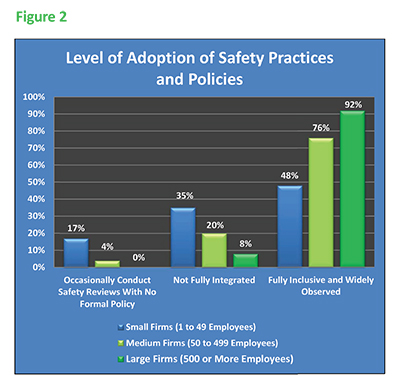New Study Demonstrates that Safety Programs Improve Business Outcomes
In 2012, the
Bureau of Labor Statistics reported that the construction industry has the
second-highest rate of fatal work injuries in the U.S., demonstrating the need
to make safety programs a priority. Now a new SmartMarket Report, published by
McGraw Hill Construction in partnership with ClickSafety, CPWR and United
Rentals, reveals that investing in safety practices is not only a way to
address this grim statistic, but that these investments also can yield
significant business returns. Large construction companies—those with 500 or more employees—have recognized these benefits and have broad
safety programs; but small firms, especially those with fewer than 50
employees, still need to increase their commitment to a fully inclusive and
widely observed safety program. In addition, trends and tools such as building
information modeling (BIM), mobile tools, and prefabrication are helping to
increase job site safety.
Strong Business Benefits
Given the
relatively low cost involved in implementing a strong safety program across an
organization, the return on investment (ROI) is striking. Of the contractors
surveyed, 71% report reductions in reportable injuries, and these reductions
have strong productivity and reduced liability implications. In fact, the
results of reduced injuries are evident in the positive benefits respondents
attribute to safety programs, including a positive impact on project ROI,
schedule, and budget. The size of these impacts is also notable:
49% report a decrease in project schedule by 1 week or more
73% report a decrease in project budget by 1% or more, with 24% finding
a decrease of greater than 5%
73% see a 1% or more increase in project ROI, and 20% find an increase
of greater than 5%
Given the many options that are
now available for safety training and implementation, including online training
classes, the study clearly demonstrates that investing in a safety program is a
business imperative.
Gap in Adoption Between Small and Large Firms
The research also reveals that, currently, far more
large construction companies are reaping these benefits than smaller ones.
While nearly all construction companies with 500 or more employees (92%) report
that they have fully inclusive and widely observed safety programs, less than
half (48%) of construction companies with fewer than 50 employees report the
same. Given the prevalence of smaller firms in the U.S., with a 10-employee
average nationwide, this represents an important gap that the industry needs to
fill.
Rising Trends Help Improve Safety
In 2012, McGraw Hill Construction reported that 71%
of architects, engineers, and contractors use BIM on at least some of their
projects, a dramatic growth from only 28% 5 years earlier. The demonstrates
that the rise of BIM should also help improve job site safety. Of the
respondents who use BIM, 43% find that BIM has a positive impact on safety; and
throughout the study, a higher percentage of BIM users report employing safety
practices and achieving the benefits offered by increased safety. The ability to
identify potential site hazards before construction begins is the BIM function
most widely recognized as impacting safety, although a quarter of the
respondents also consider clash detection to have positive safety impacts.
BIM is not the only emerging trend
with safety implications. The increased use of prefabrication/modularization is
also noted to have a positive impact on safety by half of the respondents who
use this approach. The key factors identified in the research that contribute
to increased safety are the ability to do complex
assembly at the ground level or off site and the need for fewer workers on site
working on different aspects of the building on projects that employ
prefabrication.
Perhaps the most surprising
finding, though, is that respondents overwhelmingly find that their mobile
tools, such as smartphones and tablets, have a positive impact on safety.
Approximately 80% report that smartphones and iPads increase safety. This
finding demonstrates that the importance of strong communication between the
office and the site, the ability to accurately document and visualize site
conditions, and the ability to deliver safety training remotely all are seen as
positive factors.


